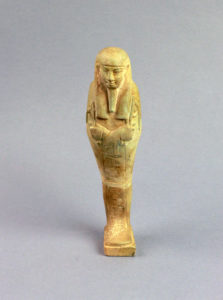Figurine, 672-332 B.C.E, Egyptian, Faience, Transfer of Scarritt-Bennett Center, 2011.37.4.
An ushabti is an Egyptian figurine that is meant to represent the deceased and be buried alongside the body, a custom which began in the Middle Kingdom. Meaning “answerer”, the figure is called on when manual labor is needed after death, so that the deceased can enjoy the afterlife. Although dressed in burial garb, the figure holds an adze, a hoe, and a seed sack typical of later examples over its left shoulder. This example has a shabti formula running vertically down the center, which is a spell meant to summon the figure to life. The legible part of the hieroglyphic inscription reads “It may be illuminated by Osiris…”. The shape and features of the face are somewhat uncommon, but this is likely attributed to the figurine’s late date and may suggest that it is from a provincial necropolis.

